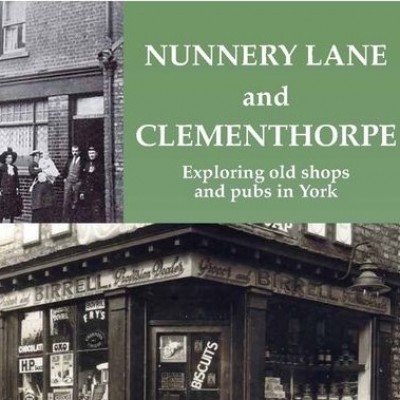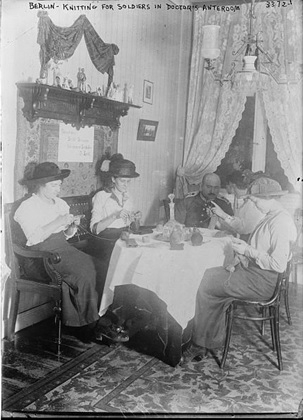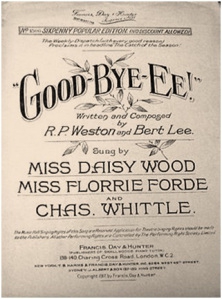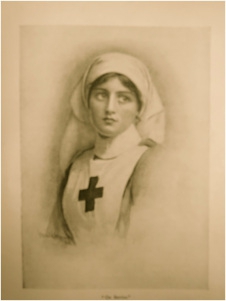



View navigation
 Anne Houson has been exploring more women’s experiences in WW1, with links to our local area:
Anne Houson has been exploring more women’s experiences in WW1, with links to our local area:Dorothy Rose Dodsworth was only eighteen years old at the start of World War One. She and her sisters Kit and Evie Dodsworth came from a privileged background. Their father was Ernest Dodsworth, a prominent York solicitor and onetime Sheriff of York.
Girls like Dorothy, who was educated at home, lived in the schoolroom until they were eighteen and ‘never met anyone’. We know this was how they saw their lives because Kit and Evie kept diaries. Parts of their diaries are reproduced in Lyn Macdonald’s book The Roses of No Man’s Land. Their original diaries are held at the Imperial War Museum and we are fortunate that they give us an insight into how the war affected these three sisters, two of whom worked in our local area.
Had it not been for the outbreak of war in 1914, Dorothy would have looked forward to being released from the schoolroom into a life of gentle pursuits like sewing, helping at church bazaars and teaching at Sunday School.
In 1914 the world changed for Dorothy and her sisters. Thousands of troops came to York. They occupied Fulford Barracks. They set up what was in effect a military village under canvas on the Knavesmire and servicemen were billeted in houses all over the city.
In common with the majority of women in 1914 and irrespective of which ‘side’ they were on, Dorothy, Kit and Evie were encouraged to knit for the war effort. The sisters lived at St Peter’s Grove, Clifton and men from the 4th Battalion of the West Yorkshire Regiment used the open space near the girls’ house for training. As the sisters sat and knitted in the big bay window at the front of the house, they got a good view of the soldiers and their activities.
Evie tells us that on 25 February 1915 they talked to lots of the soldiers that day, as the West Yorkshires were due to leave the following morning. That night, the sisters could not get to sleep until late, as a couple of soldiers stood under their bedroom windows singing and serenading them. The following morning, the sisters heard the soldiers shout ‘goodbye’ as they marched off for war. The sadness, worry and tensions the sisters felt for these soldiers is very evident in Evie’s diary.
following morning. That night, the sisters could not get to sleep until late, as a couple of soldiers stood under their bedroom windows singing and serenading them. The following morning, the sisters heard the soldiers shout ‘goodbye’ as they marched off for war. The sadness, worry and tensions the sisters felt for these soldiers is very evident in Evie’s diary.
The West Yorkshires were soon replaced by men from the King’s Own Yorkshire Light Infantry (KOYLI’s). Evie was not too impressed by these replacement troops and described them as ‘a nasty, dirty-looking lot’. The new troops stayed long enough to be trained and by 13 April 1915 they were leaving York. Evie wrote in her diary that her and her sisters wept as they watched the KOYLI’s leave York by train to go to France.
Sometime in 1915, Kit and Evie became voluntary nurses (VADs) and were intent on serving overseas. Kit at 22 years of age had a problem, as overseas voluntary nurses had to be 23 years old to go abroad. Kit describes in her diary how she ‘put a brave face on it’ and lied about her age. Very soon, Kit and Evie were at no 12 General Hospital in Rouen, France. Carrying out their day-to-day duties they would certainly not have looked like the idealised images of VAD nurses that appeared throughout the war. Kit writes about coming off a long shift at no 12 General Hospital at Rouen and breaking down in tears as she brushes her hair and discovers that it is crawling with lice.
 In 1915, Dorothy was still at home in York but her life had also changed. She had volunteered as a housemaid and orderly at Nunthorpe Hall, where she would have been expected to launder filthy uniforms, make fires, wash up, clean bedpans and worse. She was, in fact, doing a much harder job than than the family’s former housemaid, Nellie had done for her and her sisters. Red Cross records indicate that Dorothy worked at Nunthorpe Hall throughout the war. (Nunthorpe Hall was in the area now built over as Coggan Close, between Albemarle Road and Philadelphia Terrace. The Hall was demolished in 1977.)
In 1915, Dorothy was still at home in York but her life had also changed. She had volunteered as a housemaid and orderly at Nunthorpe Hall, where she would have been expected to launder filthy uniforms, make fires, wash up, clean bedpans and worse. She was, in fact, doing a much harder job than than the family’s former housemaid, Nellie had done for her and her sisters. Red Cross records indicate that Dorothy worked at Nunthorpe Hall throughout the war. (Nunthorpe Hall was in the area now built over as Coggan Close, between Albemarle Road and Philadelphia Terrace. The Hall was demolished in 1977.)
We also know from Red Cross records, that Kit and Evie returned from France in the first half of 1916 and it was probably during 1916 that either Kit or Evie as well as Dorothy started work as munitions workers at T E Cooke’s at Bishophill (see here).
Kit and Evie left York in 1916 to go and work at hospitals in Birmingham and Brighton. We do not know if Dorothy continued to work at T E Cooke’s. In 1917 Kit and Evie went overseas again. They sailed from Marseilles on board HM troop ship The Aragon on 17 December 1917 and arrived at Alexandria on 30 December 1917. Life changed again forever for Kit and Evie. The Aragon was torpedoed and took just 15 minutes to sink. Kit and Evie managed to get into a lifeboat with other nursing staff and watched as HM destroyer Attack took on board men from The Aragon. Then Attack was torpedoed. Some of the survivors were pulled into Kit and Evie’s lifeboat in various states of consciousness and dress. Kit’s personality shines through in her diary entry where she describes one of the survivors who had arrived in the lifeboat without his kilt, being re-dressed in the only thing to hand – a pair of ladies knickers! 610 of a total of 2,700 passengers from The Aragon died at sea. Kit and Evie carried on nursing in Alexandria until January 1919.

All three sisters made what their parents would have called ‘ good marriages’, to men with military backgrounds. Exactly a week after armistice was declared, Kit married Lieutenant C A Vaughan-Phillips at the British consulate in Cairo. Evie married Captain Leslie Mardaunt Ladell at St Olave’s church in York on 12 June 1919. Dorothy married Edward Cotton Jury in York in 1932.
Evie Ladell died in 1935 in Hertfordshire.
Kit Vaughan-Phillips died in 1986 in Dorset.
Dorothy Jury died in 1972 and is buried in Enniskerry in Ireland.
We have found records for two men from our area who served with the King’s Own Yorkshire Light Infantry. In all probability, they were nursed and cared for at some point by volunteer personnel, like Dorothy, Kit and Evie.
Private 33547 Sydney Dennet Batchelor, 6th Battalion KOYLI died on 9 March 1917 as a result of wounds. It is likely that he died at no 37 Casualty Clearing Station at Avesnes, France. His parents lived at 15 Charlton St, York. Private Batchelor is commemorated on the war memorial to the pupils of Cherry St School, which is in St Clements Church, Scarcroft Road York. He is also commemorated on the Rowntree’s Memorial at Haxby Road.
Private 38286 Thomas Francis Bell, 2nd Battalion KOYLI died on 23 August 1918 as a result of wounds. His next of kin Harriet Mabel Bell, nee Easey, lived at 18 Charlton Street. He left a son, also called Thomas, then aged 2. Private Bell is commemorated in the King’s Book at York Minster.
Steven Fuller, The Bedfordshire Regiment in the Great War; The Sinking of the SS Aragon 30 December 1917 accessed at : http://bedfordregiment.org.uk/5thbn/ssaragon.html 27 March 2017.
Lyn MacDonald, The Roses of No Man’s Land: Nurses on the Western Front (London: Penguin, 1980)
Berlin — knitting for soldiers in Doctor’s anteroom. c 1915. Bain News Service, Publisher. . Photograph. Retrieved from the Library of Congress, at:
https://www.loc.gov/item/ggb2005018433/ (Accessed March 28, 2017.)
Goodbye-ee. Cover of song sheet of song made popular in 1917 by Florrie Ford.
On Service 1918 from The Illustrated War Record of the most notable episodes in the Great European War and reproduced as an engraving by Raphael Tuck, published London 1918